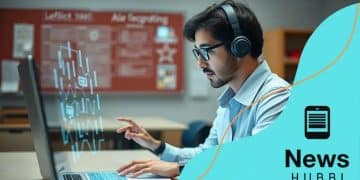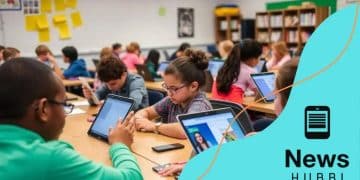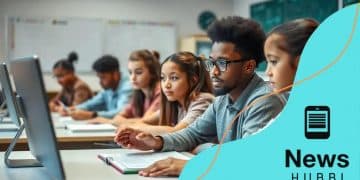How to create a blended learning environment in schools

Anúncios
Blended learning in schools integrates traditional teaching with online resources, enhancing student engagement and personalized learning while allowing for flexible access to educational materials.
How to create a blended learning environment in schools is a question many educators are exploring today. Blending traditional teaching with digital tools offers exciting opportunities to enhance student engagement and learning outcomes. So, how can schools effectively implement this approach?
Anúncios
Understanding blended learning concepts
Understanding blended learning concepts is essential for teachers and administrators who want to enhance education in schools. By merging traditional classroom techniques with digital tools, educators can provide a richer learning experience for students. This blended approach allows for flexibility and can cater to various learning styles.
Blended learning typically involves several key elements that contribute to its success. One major aspect is the integration of online and face-to-face instruction. This combination makes lessons more engaging and allows learners to access resources anytime.
Key components of blended learning
In a blended learning environment, there are a few vital components that need attention. Schools should focus on:
Anúncios
- Technology access: Ensuring students have devices and reliable internet.
- Curriculum design: Crafting lessons that effectively combine digital and in-person elements.
- Teacher training: Providing educators with professional development to adapt to new teaching strategies.
Moreover, implementing blended learning can support personalized learning. Each student has unique needs, and this approach allows them to progress at their own pace. Teachers can use assessments and data to tailor instructions, making learning more effective.
As schools begin to embrace blended learning, understanding its core principles becomes imperative. Not only does this model enhance student engagement, but it also prepares them for future workplaces, which often blend in-person and remote elements. When students become accustomed to this learning style, they develop vital skills for their futures.
Blended learning is also highly adaptable. It enables teachers to innovate and make adjustments based on student needs and feedback. For instance, if a particular digital tool is not resonating with students, educators can explore alternative resources that may better fit their learning preferences.
The role of digital tools
Digital tools in blended learning serve as a bridge between instructors and students. Various platforms can facilitate collaboration, enhance interaction, and provide instant access to materials. This accessibility enhances the overall learning experience.
- Online forums for discussions and peer collaboration.
- Learning management systems for course materials.
- Interactive multimedia resources to enrich lessons.
As schools understand blended learning concepts, they will see increased student engagement and achievement. The flexibility offered by this model empowers students to take ownership of their education, ultimately fostering a generation of self-directed learners.
Benefits of blended learning in education
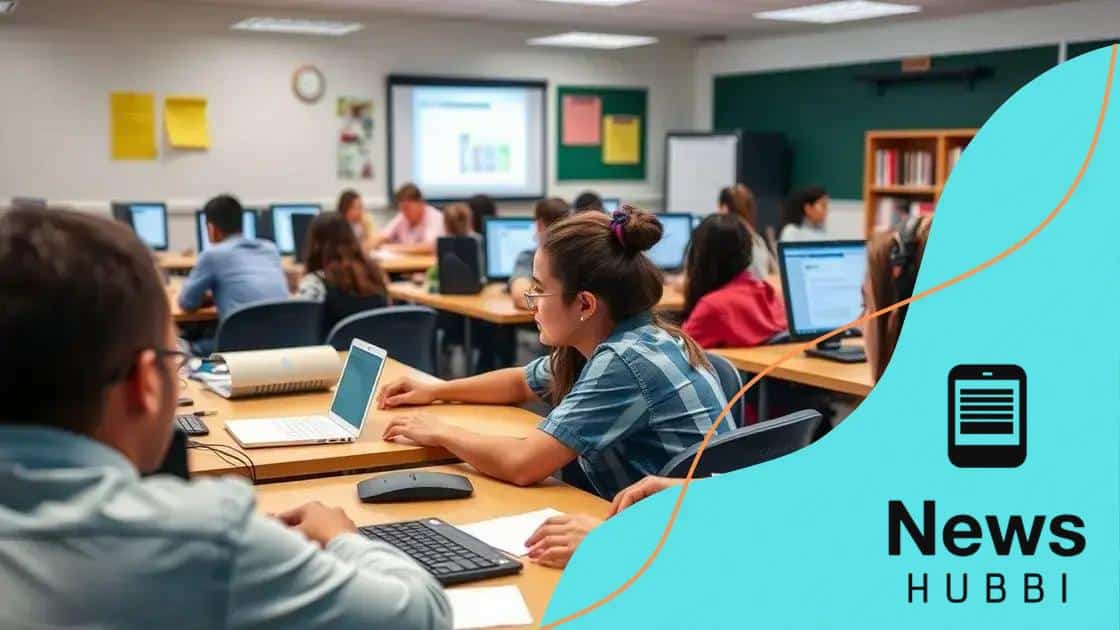
The benefits of blended learning in education are numerous and impactful. This approach combines traditional classroom methods with online learning, creating a versatile environment for students. Children can learn at their own pace, and teachers can personalize their instruction.
By using blended learning, educators can enhance student engagement. When students interact with technology and collaborate with peers, their interest in the material often increases. This approach makes lessons more dynamic and encourages participation.
Improved flexibility and accessibility
Another major benefit of blended learning is flexibility. Students can access resources anytime and anywhere, making learning more convenient. This is especially helpful for those who may have commitments outside of school.
- Students can review materials at their own pace.
- Flexible schedules allow learning to fit into students’ lives.
- Access to a wider range of resources enhances learning.
Additionally, blended learning promotes self-directed learning. When students have control over their own learning paths, they become more responsible. They are encouraged to take ownership of their education, developing skills that are crucial for their future.
Teacher feedback is also improved with blended learning. In a traditional classroom, it can be challenging to provide individual attention to each student. However, with digital tools, teachers can track progress and respond to learners more efficiently.
Fostering collaboration
Blended learning environments foster better collaboration among students. Group projects can easily incorporate online elements, enabling students to work together regardless of location. This teamwork skill is something they will benefit from in their careers.
- Students learn to communicate effectively with peers.
- Collaboration fosters a sense of community in the classroom.
- Sharing ideas enhances creative thinking.
Through the adoption of blended learning, schools can create a more engaging and effective educational experience. The combination of various learning methods caters to different styles and prepares students for a rapidly changing world.
Key components for a successful blended environment
Creating a successful blended learning environment requires understanding its key components. These components play a vital role in how effectively students engage and learn. It’s important for educators to consider each element when designing their programs.
One major component is the integration of technology. Having the right tools is essential to facilitate learning. Schools should ensure that students have access to reliable devices and high-speed internet. This access allows students to participate in online learning experiences, which can enhance their understanding of the material.
Curriculum Design
Another crucial aspect of blended learning is the curriculum design. Educators need to create lessons that combine traditional instruction with online elements effectively. This might include video lectures, interactive activities, and assessments that promote engagement. By thoughtfully designing the curriculum, teachers provide various learning opportunities for all students.
- Incorporating multimedia resources to appeal to different learning styles.
- Ensuring assessments are available online for easy feedback.
- Creating collaborative projects that leverage both in-person and digital tools.
Professional development for teachers is also key. Teachers need training to adapt to new technologies and teaching methods. By equipping them with the necessary skills, schools can ensure that educators feel confident in implementing blended learning strategies.
Moreover, ongoing assessment and feedback are vital to a successful blended environment. This allows educators to monitor student progress and make adjustments as needed. Regular check-ins and communication can help identify areas where students may need additional support.
Community and Collaboration
Lastly, fostering a sense of community is important. Collaboration among students can enhance the learning experience. Schools can create opportunities for students to work together on projects and discussions, both in-person and online.
- Encouraging peer interactions through group assignments.
- Using discussion forums for students to share ideas and resources.
- Holding regular meetings, whether virtual or physical, to strengthen community ties.
By focusing on these key components, schools can create an effective and inclusive blended learning environment that benefits all students, helping them to thrive in their educational journeys.
Strategies for implementing blended learning
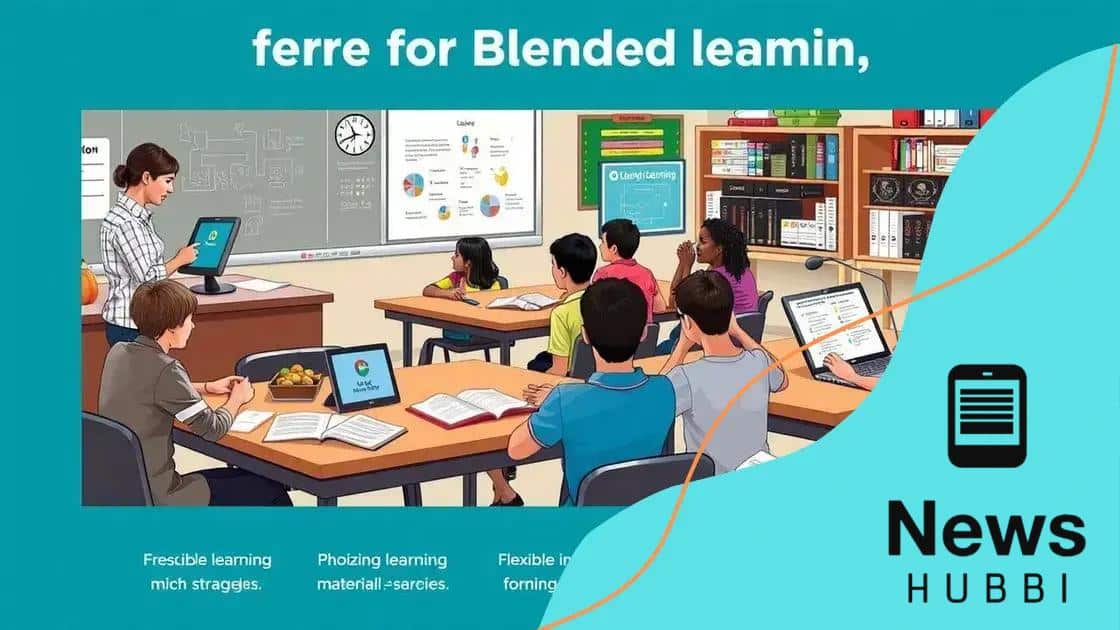
Implementing blended learning requires careful planning and creativity. There are several strategies for implementing blended learning that can help educators create an effective program. These strategies include integrating technology, supporting educators, and involving students in the learning process.
First, schools should focus on integrating the right technology into classrooms. This includes providing students with access to devices, such as laptops and tablets, as well as ensuring reliable internet connections. With these tools in place, students can engage with online content alongside traditional lessons. This combination of resources can enrich their educational experience.
Professional Development for Educators
Another key strategy is offering professional development opportunities for educators. Teachers need support to adapt to blended learning techniques. Training programs should cover how to use technology effectively and how to design engaging and interactive lessons.
- Workshops on using digital tools like learning management systems.
- Peer collaboration to share best practices and experiences.
- Access to online courses focusing on blended learning methods.
In addition to supporting teachers, involving students in their learning process is essential. When students have a say in how they learn, they often become more motivated. Encouraging student input in selecting learning materials or tools fosters a sense of ownership over their education.
Creating a Flexible Learning Environment
Building a flexible learning environment can also enhance blended learning. This means allowing students to progress at their own pace and learn in ways that suit their individual styles. Schools can introduce a mix of synchronous (live) and asynchronous (on-demand) learning opportunities to accommodate different preferences.
- Offering recorded lectures for students to revisit.
- Encouraging group projects that can be done online or in-person.
- Using various assessment methods to gauge student understanding.
Lastly, regular feedback and assessment can drive success in a blended learning environment. Educators should continuously evaluate student progress and adjust lessons based on feedback. This helps ensure that students receive the support they need while fostering a collaborative and engaging atmosphere.
Assessing the impact of blended learning initiatives
Assessing the impact of blended learning initiatives is crucial for understanding their effectiveness. By measuring the outcomes, educators can determine what works and what needs improvement. This assessment helps schools make informed decisions about their blended learning programs.
One important aspect of assessment is tracking student engagement. Tools like online surveys and classroom observations can provide valuable insights into how actively students participate in both digital and in-person activities. High levels of engagement often correlate with better academic performance.
Measuring Academic Performance
In addition to engagement, it’s essential to measure academic performance. Schools can utilize standardized tests, projects, and other assessments to analyze how well students are learning in a blended environment. Comparing test scores before and after implementing blended learning can showcase its effectiveness.
- Using formative assessments to gauge student understanding throughout the course.
- Implementing summative assessments to evaluate overall learning at the end of units.
- Encouraging self-assessments where students reflect on their learning experiences.
Another factor to consider is feedback from both students and teachers. Gathering opinions about how blended learning is affecting their experiences can provide deeper insights. Feedback can highlight areas of success and pinpoint challenges that need to be addressed.
Analyzing Learning Outcomes
Additionally, analyzing learning outcomes is vital. Schools should look at data over time to see trends in student performance and engagement levels. This data can guide educators in making necessary adjustments to teaching methods and resources.
- Identifying specific subjects or areas where students excel or struggle.
- Looking for correlations between technology use and academic success.
- Examining attendance and participation rates in both online and face-to-face activities.
Ultimately, a comprehensive assessment process helps schools refine their blended learning strategies, ensuring that they meet students’ needs effectively. By continually evaluating and adjusting their initiatives, educators can create an enriching learning environment that benefits all students.
In conclusion, assessing the impact of blended learning initiatives is vital for improving educational outcomes. By focusing on student engagement, academic performance, and continuous feedback, educators can refine their methods to better support learners. Implementing effective strategies leads to a more engaging and personalized learning experience, benefiting both students and teachers. Ultimately, a thoughtful approach ensures that blended learning meets the diverse needs of the classroom, preparing students for a successful future.
FAQ – Frequently Asked Questions about Blended Learning Initiatives
What is blended learning?
Blended learning combines traditional face-to-face teaching methods with online learning activities, providing a flexible and engaging educational experience.
How can I assess student engagement in a blended learning environment?
You can assess student engagement through surveys, classroom observations, and monitoring participation in online discussions and activities.
What tools are useful for measuring academic performance in blended learning?
Standardized tests, formative assessments, and self-assessments are effective tools for measuring academic performance in a blended learning setting.
How can I effectively involve students in their own learning?
Encourage students to provide input on learning materials and methods, and incorporate their feedback into lesson plans to enhance their ownership of the learning process.
